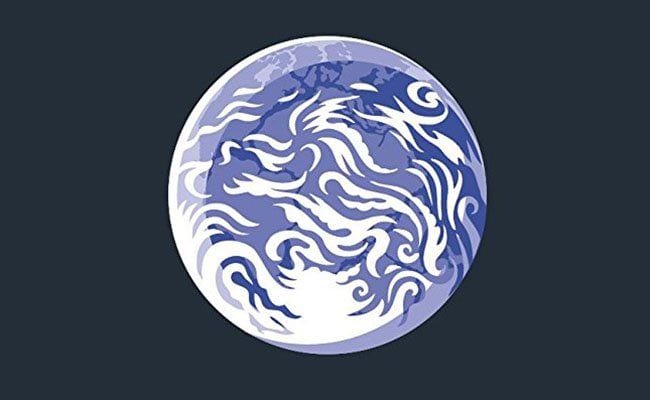
Earth, written by Jeffrey Jerome Cohen and Linda T. Elkins-Tanton, is part of Bloomsbury Academic’s Object Lessons series, “a series about the hidden lives of ordinary things.” Other subjects in this series include the egg, the cigarette lighter, and the shipping container.
I’m not certain I would put the Earth in quite the same category as some of the other objects in this series, but I’m glad series editors Ian Bogost and Christopher Schaberg thought differently — because Earth is a magical, unusual, curious book.
Earth is also like a lot of trendy things these days in that it involves a seemingly unusual pairing. Arguably, Earth partners something even more unlikely than pumpkin and coffee or Nutella and bacon: an English professor (Jeffrey Jerome Cohen) and a planetary scientist (Linda T. Elkins-Tanton). Their letters, texts, along with an occasional Facebook post and a transcript or two create a book that’s more conversation than text which, according to the prologue, is exactly what the authors were hoping for.
Cohen and Elkins-Tanton assure us that “Earth is faithful to the modes in which it was composed. The letters that we sent each other are not fictions. Though revised for coherence and to provide a sense of fullness and completion, the various transcripts, social media updates and instant messages are the actual technologies and genres through which the book was written, not a literary conceit.”
Their letters, as letters tend to do, often open with less than Earthly subjects — a son going to college, health concerns, birthdays, cake. They let us see Cohen and Elkins-Tanton as people — and fun, smart people at that. Because of this, I want little more than to join Elkins-Tanton while she drinks prosecco, eats jelly beans, and corresponds with Cohen about the Earth.
Many times, these more personal elements do relate back to the titular subject of the book. A son traveling across country to attend college connects to a discussion about time, space and size — none of which can we truly comprehend: “…then there is length. Time is bad enough, but length, size, volume are also impossible. We have a good sense of the distances we can walk or bicycle and a warped sense of driving. We cannot really comprehend planet-scale processes, cannot really comprehend the size of the Earth…”
Similarly, a recent drought in the western United States is linked to a much larger discussion of the Earth’s water supply. Here the authors discuss the origins of Earth’s water supply, talk about the threat of global warming, compare the “wetness” of Arizona to that of the Moon and Mars, and lament the greenness of pricey golf courses — even during a drought.
There’s a chapter on beauty as well, and this is probably not surprising — a book on the Earth that didn’t talk about the beauty of the planet might seem odd. This chapter is titled “Radiance” and certainly talks about the Earth’s beauty but at times the larger focus seems to be science and the way it’s viewed — in particular looking at the relationship between science and beauty.
Earlier in the book, Elkins-Tanton writes to Cohen: “Scientists do not talk of beauty as much as we might. Beauty is at the center of all we do, though; it is the emotion and response that compels us to study the things we do.” In “Radiance”, these thoughts are expanded. After joking (but at the same time probably not joking) that in academia “pre-tenure scientific faculty do not speak about beauty very much (too personal! irrelevant! soft!)” the discussion becomes more serious:
In a broad sense beauty is the reason we all do what we do, why we choose the field we choose, and what gives us the determination to keep working in the face of discouragements. We do not choose to study the minerals in lava flows because it was an obvious career alternative to the law, we do it because lava is beautiful and the notion of interrogating the untouchable heart of the planet through incandescent molten eruptions appeals to our unconscious understanding of human relations and our place in them.
The discussion of what is (or perhaps what should be considered) scientific doesn’t end with beauty, Cohen and Elkins-Tanton also make connections between science, creativity, and imagination (and the Earth), asking questions like, “Why when it comes to Earth does human imagination luxuriate in beauty but not initiate action and change?” and “Where does the known end and the imagination begin?”
Earth is a tiny book. Not even 150 pages (including illustrations, chapter notes, and the index), it’s slim, and the pages are small — the book not much bigger than my hand. Cohen and Elkins-Tanton describe it as a “little book about an impossibly large subject.” This subject is made even larger by Cohen and Elkins-Tanton’s forays into discussions of beauty, creativity, and imagination (including my favorite question in the book: “Can you die from an overactive imagination?”) and how they connect to science and ultimately this planet. This makes Earth a book that is, ultimately, a testament to what can be discovered if we are brave enough to combine the unexpected.


![Call for Papers: All Things Reconsidered [MUSIC] May-August 2024](https://www.popmatters.com/wp-content/uploads/2024/04/all-things-reconsidered-call-music-may-2024-720x380.jpg)



